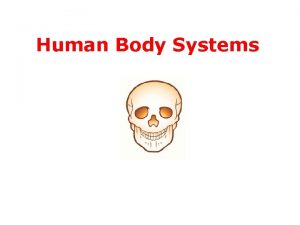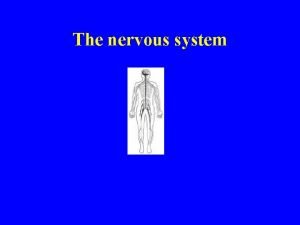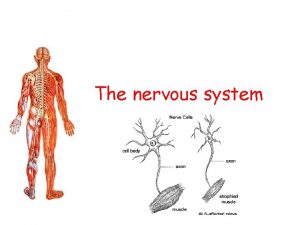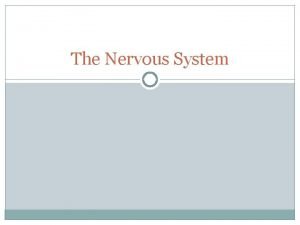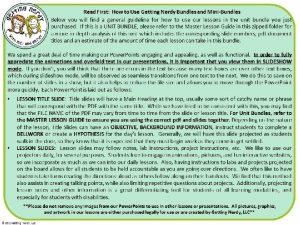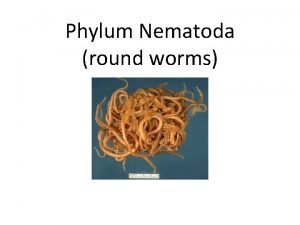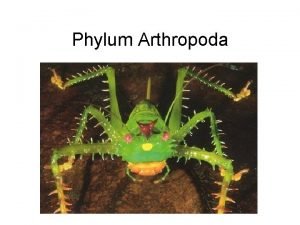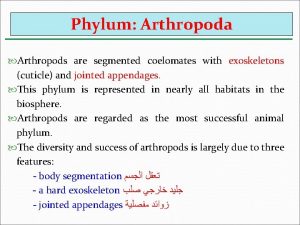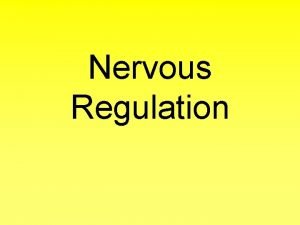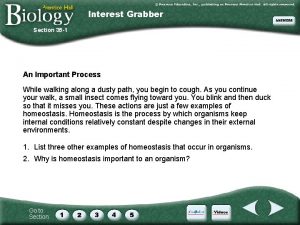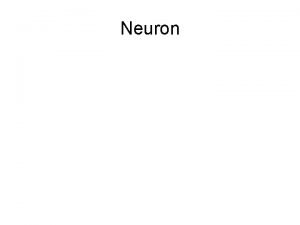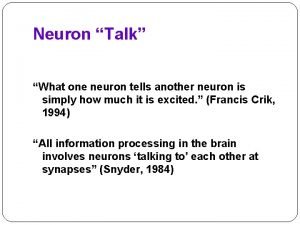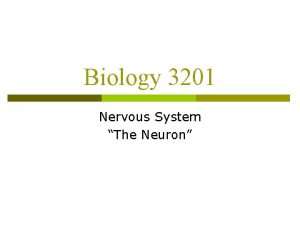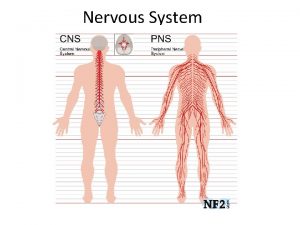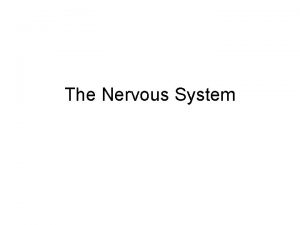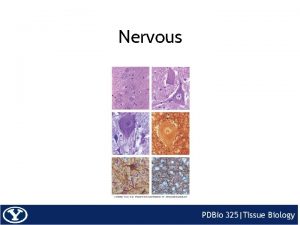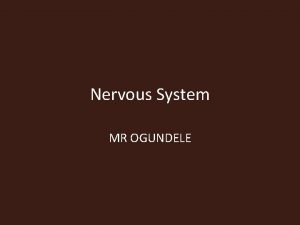Nervous System Part II How A Neuron Works



































- Slides: 35

Nervous System: Part II How A Neuron Works

Essential Knowledge Statement 3. E. 2 Continued Animals have nervous systems that detect external and internal signals, transmit and integrate information, and produce responses 2


Identify the Numbered Structures

Describe a Resting Potential: • What is the charge inside the neuron at rest? • Why is the cell negative inside and positive outside? (be specific) 5

Source of Charge Differences: 6

Action Potential • Action potentials propagate impulses along neurons. – Membranes of neurons are polarized by the establishment of electrical potentials across the membranes. – In response to a stimulus, Na+ and K+ gated channels sequentially open and cause the membrane to become locally depolarized. – Na+/K+ pumps, powered by ATP, work to maintain membrane potential. 7

Label the graph of the action potential as we go through the next several slides. 8

Generation of Action Potentials: A Closer Look • An action potential can be considered as a series of stages • At resting potential 1. Most voltage-gated sodium (Na+) channels are closed; most of the voltage-gated potassium (K+) channels are also closed

Key Na K Membrane potential (m. V) 50 0 Threshold 50 100 OUTSIDE OF CELL INSIDE OF CELL Inactivation loop 1 Resting state Sodium channel Potassium channel 1 Resting potential Time

• When an action potential is generated 2. Voltage-gated Na+ channels open first and Na+ flows into the cell 3. During the rising phase, the threshold is crossed, and the membrane potential increases to and past zero

Key Na K Membrane potential (m. V) 50 0 50 2 Depolarization OUTSIDE OF CELL INSIDE OF CELL Inactivation loop 1 Resting state 100 Sodium channel Potassium channel Threshold 2 1 Resting potential Time

• When an action potential is generated 2. Voltage-gated Na+ channels open first and Na+ flows into the cell 3. During the rising phase, the threshold is crossed, and the membrane potential increases to and past zero 4. During the falling phase, voltage-gated Na+ channels become inactivated; voltagegated K+ channels open, and K+ flows out of the cell

Key Na K 50 Rising phase of the action potential Membrane potential (m. V) 3 Depolarization OUTSIDE OF CELL INSIDE OF CELL Inactivation loop 1 Resting state 100 Sodium channel Potassium channel 3 0 50 2 Action potential Threshold 2 1 Resting potential Time

Key Na K 50 Rising phase of the action potential Membrane potential (m. V) 3 Depolarization OUTSIDE OF CELL INSIDE OF CELL Inactivation loop 1 Resting state 100 Sodium channel Potassium channel Falling phase of the action potential Action potential 3 0 50 2 4 Threshold 2 1 Resting potential Time 4

5. During the undershoot, membrane permeability to K+ is at first higher than at rest, then voltage-gated K+ channels close and resting potential is restored

Key Na K 50 Rising phase of the action potential Membrane potential (m. V) 3 Depolarization OUTSIDE OF CELL 100 Sodium channel Potassium channel Falling phase of the action potential Action potential 3 0 50 2 4 Threshold 2 4 1 5 Resting potential Time INSIDE OF CELL Inactivation loop 1 Resting state 5 Undershoot 1

Figure 48. 11 a 50 Membrane potential (m. V) Action potential 3 0 2 50 4 Threshold 1 Resting potential 100 Time 5 1

Refractory Period • During the refractory period after an action potential, a second action potential cannot be initiated • The refractory period is a result of a temporary inactivation of the Na+ channels

Conduction of Action Potentials • At the site where the action potential is generated, usually the axon hillock, an electrical current depolarizes the neighboring region of the axon membrane • Action potentials travel in only one direction: toward the synaptic terminals

• Inactivated Na+ channels behind the zone of depolarization prevent the action potential from traveling backwards

Axon Action potential 1 Na Plasma membrane Cytosol

Axon Plasma membrane Action potential 1 Cytosol Na K 2 Action potential Na K

Axon Plasma membrane Action potential 1 Cytosol Na K 2 Action potential Na K K 3 Action potential Na K

Sequence the following in order of occurrence • Depolarization • Resting state • Repolarization • Hyperpolarization

Sequenced in order of occurrence • Resting state • Depolarization • Hyperpolarization • Resting state

50 Membrane potential (m. V) ? 3 • Resting state 0 • Depolarization 2 • Hyperpolarization 50 ? • Repolarization 1 • Resting state ? 100 Time 4 5 1

A(n) ___ in Na+ permeability and/or a(n) ___ in K+ permeability across a neuron’s plasma membrane could shift membrane potential from − 70 m. V to − 80 m. V. a. increase; increase b. increase; decrease c. decrease; increase d. decrease; decrease

Adding a poison that specifically disables the Na+/K+ pumps to a culture of neurons will cause a. the resting membrane potential to drop to 0 m. V. b. the inside of the neuron to become more negative relative to the outside. c. the inside of the neuron to become positively charged relative to the outside. d. sodium to diffuse out of the cell and potassium to diffuse into the cell.

Name three specific adaptions of the neuron membrane that allow it to specialize in conduction 30

Evolutionary Adaptations of Axon Structure • The speed of an action potential increases with the axon’s diameter • In vertebrates, axons are insulated by a myelin sheath, which causes an action potential’s speed to increase • Myelin sheaths are made by glia— oligodendrocytes in the CNS and Schwann cells in the PNS

Node of Ranvier Layers of myelin Axon Schwann cell Axon Myelin sheath Nodes of Ranvier Schwann cell Nucleus of Schwann cell 0. 1 m

Can you explain why impulses travel faster in myelinated sheaths?

Next time we will explore what happens when the impulse reaches the end of the axon. 34

Created by: Debra Richards Coordinator of Secondary Science Programs Bryan ISD Bryan, TX
 Neuronal pools
Neuronal pools Nervous
Nervous What are neuron processes
What are neuron processes Smoking damages your lungs
Smoking damages your lungs Chemical synapses
Chemical synapses Cns
Cns Which part of the neuron serves as the protective coating?
Which part of the neuron serves as the protective coating? Streetworks revision
Streetworks revision Nervous system and digestive system
Nervous system and digestive system Endocrine system vs nervous system
Endocrine system vs nervous system Mechanism of hormone action
Mechanism of hormone action Adh function
Adh function Chemical messengers of the nervous system
Chemical messengers of the nervous system Is flatworm asexual reproduction
Is flatworm asexual reproduction The nervous system is made up of
The nervous system is made up of What are the three basic functions of the nervous system
What are the three basic functions of the nervous system Nervous system learning objectives
Nervous system learning objectives Chapter 7 the nervous system
Chapter 7 the nervous system Stimulus in nervous system
Stimulus in nervous system Nervous system objectives
Nervous system objectives Autonomic nervous system visceral
Autonomic nervous system visceral Autonomic nervous system def
Autonomic nervous system def 31 nerves
31 nerves Sns somatic nervous system
Sns somatic nervous system Brain scienstructable
Brain scienstructable Autonomic nervous system pathway
Autonomic nervous system pathway Roundworms nervous system
Roundworms nervous system Arthro drama
Arthro drama Chelicerates antennae
Chelicerates antennae Are arthropods coelomates
Are arthropods coelomates Division of nervous system
Division of nervous system Parasympathatic
Parasympathatic Nervous system in coelenterates
Nervous system in coelenterates Autonomic nervous system consists of
Autonomic nervous system consists of Module 10 the nervous and endocrine systems
Module 10 the nervous and endocrine systems Section 35-4 the senses
Section 35-4 the senses



